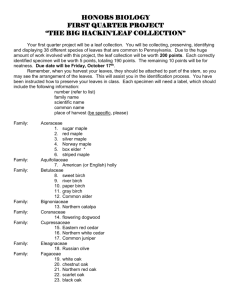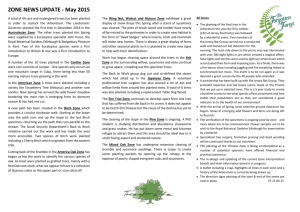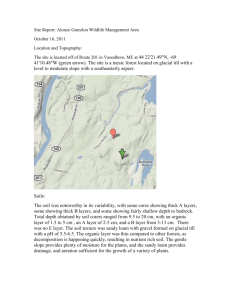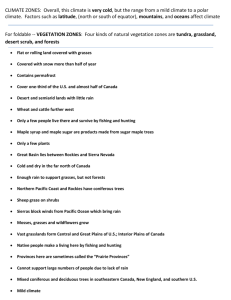University of Colorado at Boulder Tree Walk
advertisement
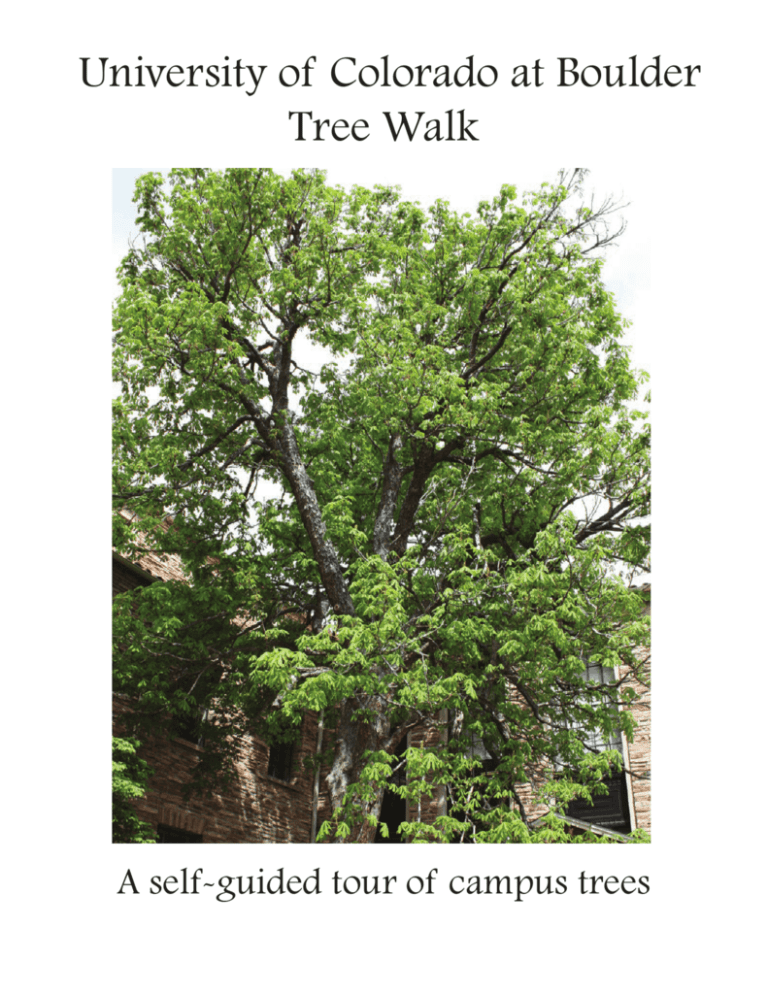
University of Colorado at Boulder Tree Walk A self-guided tour of campus trees The University of Colorado at Boulder was founded in 1876 on a treeless plain. Almost immediately, students, staff and faculty began to plant trees, determined to build a campus landscape like those they knew from the East and Midwest. Some trees were collected from the Boulder Creek floodplain, some were purchased from local nurseries, and others were shipped here on “tree trains”. A number of trees on campus are volunteers (they seeded themselves). T rees are constantly changing and responding to a variety of both human natural influences. Disease, pests and insects all take their toll. Dutch Elm Disease, for example, killed more than 1,000 American elms on campus during the 1960s and 1970s. T he life of a tree on the Boulder campus is not an easy one. Extreme weather causes damage, especially the moisture-laden snow that comes with our late spring storms. Boulder is well known for high winds that further injure campus trees. Construction and work staging present challenges as well. Trenching and excavation create major stress for trees that is often not evident for several years. Drought puts additional strain on our trees, particularly newly planted ones. Over the years, many people have contributed to the planting and tending of the 4,000 or more trees under the care of CU’s Facilities Management and the 1,000 maintained today by the Housing Department. Enjoy your time on campus and enjoy our trees. They represent a unique, valuable, and aesthetically pleasing resource for all of us. TREE DESCRIPTIONS 1. Norway Maple (Acer platanoides) This Eurasian maple is widely used in the U.S. as a shade tree. Classified as one of the hard maples, it grows moderately fast, is dust and pollution tolerant, and disease and insect resistant. Its leaves are similar to those of the sugar maple but darker and thicker and have a milky juice; they appear earlier and last longer than those of our native maples. 2. Tatarian Maple (Acer tataricum) This small maple is native to Southeast Europe and Western Asia. It is close in form and overall appearance to the more common ginnala maple, but does not have ginnala’s consistent fall color. Both ginnala and tataricum can be pruned to tree form or can be maintained as a multi-stemmed shrub. 3. Buckthorn (Rhamnus cathartica) Buckthorn, one of the many names of this tree, is usually found in the Pacific Northwest growing from sea level to moderately high elevations. Buckthorn was first documented by the Lewis and Clark Expedition. Its bark was used by Native Americans to heal wounds and ailments. Its leaves are alternate and its black fruit is eaten by birds. 4. Redbud (Cercis canadensis) The redbud is most commonly used as an ornamental tree because of its vivid lavender to pink blossoms that bloom in early spring before its leaves appear. The large, heart-shaped leaves are thicker than those of most deciduous trees and relatively smooth to the touch. The redbud has flattened pod-shaped fruit that look similar to pea pods. 5. Red Maple (Acer rubrum) This maple, often planted for shade and its moderately rapid growth, is said to be the most prevalent tree in eastern North America. In the fall, this tree’s leaves will turn a beautiful scarlet or orange color. Its wood is used for furniture, crates, or paper. This tree was vandalized in the winter of 2006; its survival is unlikely. 6. Baldcypress (Taxodium distichum) A member of the redwood family, the baldcypress grows mainly in swampland, but can survive in other wet environments. Its trunk is commonly swollen or fluted at the base, adding to the large appearance of the tree. The baldcypress is one of the very few deciduous conifers that drop all its needles in the fall. 7. Little-leaf Linden (Tilia cordata) This variety of Linden is a European native. Its heart-shaped leaves have unequal bases (the two sides of the leaf meet the stem at different places). The little-leaf linden is one of the ornamental trees planted in Colorado most commonly. It grows best when planted in a lawn or grassy area, rather in a concrete planter or near asphalt, because its roots remain cooler. This tree was moved with a tree spade about 10 years ago, but it hasn’t grown very much since then. 8. Hemlock (Tsuga canadensis) Two different species of hemlock can be found in the western United States. The western hemlock (Tsuga heterophylla) is one of the four tree species that contribute the most timber. These hemlocks grow from sea level to some 6,000 feet, and can be 175-250 feet in height. The mountain hemlock (Tsuga mertensiana) is one of the largest trees in alpine regions growing at elevations up to 11,000 feet. Hemlock groves in these areas are good shelter for bird nests and the tree’s seeds are a source of food for birds. 9. Columnar English Oak (Quercus robur) English oak is a large, slow growing non-native species that resembles the white oak, but with smaller leaves and acorns growing on 1-3 inch stalks. The term, columnar, describes the tree’s tendency to grow very straight and upright. 10. American Elm (Ulmus americana) American elm was once very abundant in the United States. Due to the devastating effects of Dutch Elm Disease (a bark beetle borne fungus), this inverted vase-shaped tree has been significantly reduced in number. The CU campus used to contain about 1,000 American elm trees until Dutch Elm Disease ravaged the Boulder area. The campus now has fewer than 40 American elms remaining. 11. Hackberry (Celtis occidentalis) Hackberry is a Colorado native and varies in size from short and shrubby to more than 100 feet tall. It has serrate (toothed) leaves and small, dark purple pitted fruit eaten by birds. Hackberry trees are susceptible to a mite parasite that causes the formation of galls on its leaves. The bark looks as if it is covered with warts. It is an excellent tree to plant in water restricted areas because it is drought tolerant. 12. Rocky Mountain Juniper (Juniperus scopulorum) This shrub-like tree is native to Colorado. It can grow to over 40 feet tall but its growth is often stunted in poor soils and drier areas of the Rocky Mountains. Its leaves are thin and pointed when young and develop an overlapping-scale pattern as they age. Juniper wood is very fragrant when burned and the cones (which look like little blueberries and take two years to mature) are used to flavor gin. 13. American Basswood/American Linden (Tilia americana) Like the little-leaf linden, the American basswood has heart-shaped leaves but are much larger. It is often planted as an ornamental or shade tree, but when harvested, its wood has many uses and is prized by wood-carvers. Both lindens are valued for the honey made from their flowers. 14. Sugar Maple (Acer saccharum) Sugar Maple is one of our most valuable trees. Its strong, hard wood is very durable and important for a wide range of commercial uses. Its sap is used to make maple syrup. An important ornamental, the sugar maple is colored brilliantly in fall. Its seeds are consumed by many kinds of birds and rodents. This maple is difficult to grow in Colorado because it prefers rich, moist soil. 15. Pin Oak (Quercus palustris) The pin oak is named for the short, tough shoots that grow out of its branches but do not flower. It has a unique three-dimensional pattern of branching (branches at the top of the tree grow upward, branches in the middle grow horizontally, and branches at the bottom of the tree grow downward) and a vivid red color in the fall. The pin oak is fairly tolerant of pollution so it often is used for street planting in urban areas. 16. Austrian Pine (Pinus nigra) Used mostly in southern Europe for timber and turpentine extraction, this pine is planted in the United States as an ornamental or in windbreaks. There are several different varieties of Austrian pine in the U.S., some of which are used for construction lumber. This tree can be confused with the native ponderosa pine, but its needles are thicker and more brittle. Austrian pine is more adaptable to soil conditions than the ponderosa pine. 17. Honeylocust (Gleditsia triacanthos) Like the Kentucky coffeetree, the honeylocust has 6-12 inch compound leaves. It is well known for its fruitlong, flat seedpods that can be found on the ground throughout the fall and winter- although many seedless cultivars have been introduced recently. The honeylocust often is attacked by spider mites and other insects that cause some of the trees on CU’s campus to lose their foliage in early fall. The soft, lacy appearance of this tree makes it a popular ornamental throughout the United States. 18. Norway Spruce (Picea abies) The Norway spruce is an introduced species from Europe. This spruce has much larger cones (4-7 inches long) and grows more quickly in the eastern United States than any native species. Used for lumber in Europe, the Norway spruce is used in the United States as an ornamental, a windbreak, a Christmas tree, and for reforestation. Young leaf shoots can be used to make spruce beer.. 19. Kentucky Coffeetree (Gymnocladus dioicus) Kentucky coffeetree is tolerant of dry conditions and often planted as an ornamental. Once established, the tree is leafless for half of the year (Gymnocladus = naked branch). Its complicated leaves are doubly compound (bipinnate) and 1-3 feet in length. It is named for its coffee bean-like seeds that the early American pioneers roasted and ground to extend their coffee supply. 20. Weeping Swamp White Oak (Quercus bicolor) The swamp white oak is found normally in swampy areas and on stream banks in the northeastern United States. Its leaves are angled more sharply than those of most white oaks which have rounded lobes. This tree is a unique cultivar that exhibits a cascading main leader and branching pattern. 21. Autumn Purple Ash (Fraxinus Americana ‘Autumn purple’) Autumn purple ash is a variety of white ash named for its outstanding reddish-purple fall foliage. It is smaller than the white ash, but can grow up to 60 feet tall with open space and good growing conditions. This ash has been planted extensively in Colorado during the last 15 years. 22. Chestnut Oak (Quercus prinus) Chestnut oak, also referred to as rock oak, is usually found on rocky sites and Appalachian mountain ridges. Its hard, durable wood is used as fuel, for railroad ties, and in construction. One of the most important features of this oak is its bark, which contains high amounts of tannin, a compound used to process leather. This slow growing tree is probably 100 years old. 23. European Beech (Fagus sylvatica) Introduced to the United States from Europe (where it is a very important timber tree), the European beech is commonly used as an ornamental. This beech, like the American beech, has smooth, gray bark, but is smaller than the American variety. Beeches reproduce frequently by growing new stems from points where the root system comes close to the soil surface and occasionally grows from seed. 24. European Larch (Larix decidua) Larches are deciduous despite being members of the pine family. Their needles turn yellow and drop in the fall. This non-native larch has short needles which grow in clusters. Its small, woody cones contain 40-50 hairy scales and resemble little wooden roses. The European larch has been used for reforestation in the eastern United States and often is planted as an ornamental. It prefers moist soil and displays a consistent yellow color in the fall. 25. Black Willow (Salix nigra) Black willow is the largest of the willows and is the only willow large enough for use as commercial lumber. It is a riparian species (grows near water) and often is used to stabilize stream banks. Its alternate leaves are 3-6 inches long, lance shaped, and finely toothed. Willows have weak and brittle wood and are damaged frequently by wind and snow storms. 26. Ailanthus/Tree-of-Heaven (Ailanthus altissima) Native to eastern Asia, the Ailanthus appears in many large cities throughout the United States because it is tolerant to smoky and harsh conditions. This tree has an interesting reproductive strategy- its male and female flowers are on separate trees (these flowers are called dioecious). The tree is well known for the unpleasant fragrance emitted from the male trees in the summertime. They grow quickly and, as a result, are subject to frequent damage by storms. 27. Douglas-fir (Pseudotsuga menziesii) This long-lived, very large conifer grows from the Rocky Mountains to the Pacific Coast. Although it closely resembles a true fir in name and in form, the Douglas-fir has many distinct characteristics that set it apart. The most notable of these differences is its strange looking cone with protruding, paper bracts. These bracts, to some, appear to be the two back legs and tail of a mouse. This Colorado native produces the most timber of all American tree species and is commonly used as a Christmas tree. 28. Mugo Pine (Pinus mugo) The Mugo pine is native to the Swiss mountains. It is a small pine, but its size varies greatly from 2 to 80 feet tall. The dwarf versions of Mugo pine are often used in landscaping because it lacks a deep taproot that makes other trees difficult to move and replant. This is an unusually large specimen for Colorado. 29. American Chestnut (Castanea dentata) This small, multi-stemmed tree is an American chestnut, a once-important part of America’s timber trade. Its nuts were an important source of food. Today, the American chestnut is almost extinct. In the early 1900s a fungus called Chestnut Blight nearly wiped out all of the chestnuts in the United States. Standing dead trees became infected with insect borers and when sawn provided wormy chestnut lumber. Root sprouts like these persist from many former trees but rarely survive for more than a few years. 30. Northern Red Oak (Quercus rubra) The northern red oak grows moderately fast and displays outstanding fall color. Its straight trunk and strong wood make it a highly valued tree. Red oak is a commonly planted tree species in Boulder. 31. Yellow Buckeye (Aesculus flava) Native to the Appalachians and the Ohio and Tennessee river valleys, the Yellow Buckeye is one of the larger growing Buckeye trees. It produces large yellow flowers on wide panicles, the ensuing fruit are 2” diameter, smooth and pear shaped, containing two buckeye nuts. Our specimen has a pendulous and weeping structural form as well as an interestingly plated bark texture. 32. Boxelder (Acer negundo) The boxelder is one of the hardiest maples. Short-lived and fast growing, the boxelder is found in a wide range of habitats across the country. It is a common volunteer and reproduces readily by seed and root sprout. It is seldom planted as an ornamental (it is not very decorative) and its soft, weak wood has few commercial uses. Boxelder is the only maple with a compound leaf. 33. Cherry (Prunus spp.) Usually small and shrub-like, cherry trees are common ornamentals. The wood from the black cherry (P. serotina) and the sweet cherry (P. avitum) is prized for furniture, interior finish, and musical instruments. The fruits of cherry trees are eaten by birds that spread the seeds and propagate growth. These trees are likely the remnants of somebody’s lunch. 34. White Ash (Fraxinus americana) The white ash is the largest and most commercially important of the ashes. It has hard durable wood used to produce furniture, railroad ties, tool handles, and athletic equipment. This tree is often planted as a street or shade tree, in part, because of its lovely fall color. This tree is more than 100 years old. 35. Cottonwood (Populus saragentii) Cottonwoods usually have rounded triangular leaves and light, fluffy seeds which can be seen floating through the air during the spring. The P. saragentii species found on campus is native to Colorado. Most of the large cottonwoods on campus were planted by students in 1876. Despite their large size, cottonwoods are surprisingly short-lived, so many of the trees planted in 1876 have been removed. 36. Western White Pine (Pinus monticola) The western white pine is a large, long-lived 5-needle pine found in the mountains of the northwestern United States and Canada. It is a moderately fast growing species with cones that rarely are fertile before the tree is 4060 years old. Thin bark makes the tree susceptible to fire and insect damage. 37. Silver Maple (Acer saccharinum) Named for the silver tint on its leaves, the silver maple grows rapidly and is larger than most maples. It is commonly planted as a street or shade tree and sometimes as an ornamental, although its fall coloring is not extraordinary. This silver maple’s hard, brittle branches make it very susceptible to storm damage. Due to maintenance issues, silver maple is no longer planted on the campus. 38. Hawthorn (Crataegus spp.) This tree was planted around 1890 and is probably one of the oldest hawthorns in Colorado. There are over 1,000 species of hawthorns and most are much smaller than this tree- rarely exceeding 30 feet in height. It usually displays small, toothed leaves, berry-like fruits, and long, curved thorns. The small white flowers are speckled with red or yellow dots. Hawthorn fruits are like small apples, eaten by birds primarily. This particular hawthorn survived a great deal of stress during the Humanities building construction. Fortunately, the general contractor took some extreme measures to protect this valuable tree, with an extensive layer of mulch, supplemental watering, and excavation by hand, near the tree. 39. Eastern White Pine (Pinus strobus) One of the tallest trees in the eastern United States, eastern white pine can grow more than 150 feet in height. Until the end of the 1800s, white pine was the most important timber tree in the country and was used for ships’ masts (some claimed by England bore the blaze and stamp of the crown), clear lumber, flooring, boxes, window frames, doors, and matches. More recently these pines have been used as ornamentals, for reforestation, and as Christmas trees. 40. Scarlet Oak (Quercus coccinea) The scarlet oak has leaves similar to the pin oak. It is planted primarily as a street and shade tree and its lovely scarlet fall color and strong lateral branches (horizontally attached and which bend down and shed heavy snow loads) make it a good ornamental. This slow growing oak often is used for lumber, because of its strong, hard wood. 41. Limber Pine (Pinus flexilis) This pine is named for its flexible branches. It is a slow growing, long-lived tree with thin needles that grow in groups of five. The cones of the limber pine are thick, waxy scales that are easily bent inward and do not bear prickles. The tree is found in mountainous regions of the western United States and can survive at high elevations. Near timberline it grows outward, instead of upward, to form low ground cover. Because of its open, irregular form, limber pine often is not planted as an ornamental. 42. Green Ash (Fraxinus pennsylvanica) The green ash looks similar to the white ash with slightly smaller leaves and a smaller overall size. The tree often grows in swampy areas and along stream banks. Like the Ailanthus and the white ash, the flowers of the green ash are both dioecious and prolific producers of seeds. Green ash grows quickly and is damaged frequently by snow and wind storms. 43. Crimson King Maple (Acer platanoides ‘Crimson King’) A variety of the Norway maple, the crimson king maple has maroon-colored leaves that do not change color in the fall. Although they often are the same in size, the bright red color of its leaves throughout the summer makes the crimson king more impressive than the Norway. 44. Callery Pear (Pyrus calleryana) The callery pear was imported from China and Korean in the early 1900s in an unsuccessful attempt to breed disease resistance into other species of pear trees. The result of this experiment was several new varieties of ornamental pear found in many U.S. cities. The fruits look more like small berries than the pears we grow for food. A late freeze can prevent this pear from fruiting successfully. This tree turns purple in the fall. 45. Horse Chestnut (Aesculus hippocastanum) Native to the Balkan Peninsula in Europe and Asia, the horse chestnut is a course textured tree planted in the United States as a shade tree. The leaf is palmately compound with 7 leaflets growing out from a central point where the leaf attaches to the twig. Each spiny fruit pod breaks open to release the large brown seed which resembles a true chestnut, but is poisonous if eaten. 46. Russian Olive (Elaeagnus angustifolia) This invasive exotic species is planted all over the United States as an ornamental, although it is native to Europe and Asia. Its hardiness and its ability to grow in poor soils make it a good windbreak tree, consequently it is often planted in rows in the Plains states. Although it is called the Russian olive, it is in the willow family. Its wood is extremely tough making it difficult to prune. 47. Arborvitae (Thuja occidentalis) The northern white-cedar, T. occidentalis, is commonly called the arborvitae, which means tree of life. Its leaves are scale-like and often glandular. This slow growing tree produces a durable wood that has been used to make fence posts. The western red-cedar, T. plicata, is a large tree that grows in the Pacific Northwest. The oriental arborvitae, T. orientalis, is much smaller, and is native to China and Taiwan. 48. Schwedler Norway Maple (Acer platanoides Schwedleri) This variety of Norway maple appears less often in the United States than the common Norway maple. It has been around longer than the crimson king variety and grows more quickly. The Schwedler Norway maple is known for the purple-red color of its leaves when the tree is young. As the tree matures the leaves turn to a dark green. This tree exhibits very little fall color. 49. Colorado Blue Spruce (Picea pungens) Colorado blue spruce, the State tree and the most common tree on campus, has stiff, sharp, bluish green needles growing individually at right angles all around the branchlets. These leaves are covered with a whitish tint, present most obviously on the new growth, giving it a silvery-blue tint. The trees are medium sized, live a long time, and grow well in dry conditions. The blue spruce is used primarily as an ornamental and Christmas tree. Blue spruce often is confused with the taller Engelmann spruce, but its blue color, longer cone, and non-hairy twigs (the Engelmann has fine hairs on its twigs) help to distinguish between the two. 50. Ginkgo (Ginkgo biloba) Ginkgo biloba, an ancient gymnosperm from China, is the only living species of its genus. The sole survivor of the family Ginkgoaceae, the Ginkgo is sometimes called a living fossil because fossilized ginkgo leaves have been dated to be more than 150 million years old. Currently, it is not known to exist in the wild. It is dioecious with distinct fan-shaped deciduous leaves and yellow, cherry-like fruit (an Oriental delicacy) containing a nutlike seed. In Colorado the ginkgo grows slowly. The male tree is preferred as an ornamental tree because the female’s seed produces an unpleasant odor as it decays. 51. Sycamore Maple (Acer pseudoplatanus) Sycamore maple, a Eurasian import, has large, 5-lobed leaves and flake-like scales of bark resembling native sycamores. Its winged fruit hangs in long clusters. The sycamore maple is smaller than most maples and does not exhibit bright color in the fall. The tree does not thrive in this country and as a result, the wood is poor in quality. This maple is used commonly for street and ornamental planting. 52. White Fir (Abies concolor) Found in the Sierra Nevada region of the United Sates primarily, the white fir also grows in the Rocky Mountains. Capable of growing 150 feet tall, white fir can live more than 300 years. Its silver-blue or silver-green needles are thick, flat and bluntly pointed, usually curved, and can grow up to 3 inches in length on low branches. They are soft to the touch. The white fir’s cones are smooth, oblong, and range in color from yellow to olive green to purple. 53. Burr oak (Quercus macrocarpa) The burr oak’s leaves and acorns are larger than any other oak, hence the name, macrocarpa (macro = large, carpa = seed or fruit). Its twigs have cork-like ridges that look like growths on the bark. Planted for lumber and as an ornamental the burr oak is highly resistant to drought and even more tolerant of city pollution than most oaks. Burr oak grows slowly and displays little fall color. 54. Catalpa (Catalpa speciosa) Called the northern catalpa, or hardy catalpa, this tree grows in a variety of soils and conditions. In harsh conditions it can develop a crooked trunk. Its large, heart-shaped leaves and long, thin, bean-like fruits, called capsules, are seen on the tree throughout the winter, make the catalpa distinctive. Showy, fragrant, and erect clusters of faintly spotted white blossoms, produced in June, are the reason for the tree’s designation as speciosa, or ornamental. 55. Ponderosa Pine (Pinus ponderosa) The ponderosa pine has needles in bundles of two and three. It is native to the Rocky Mountains and Pacific Northwest. It is the most prevalent tree in the foothills west of CU’s Boulder campus. This pine is a major part of the American timber trade and can grow over 200 feet tall with a trunk more than 6 feet in diameter. Ponderosa pine is drought-resistant and regenerates well after fire. The thick bark of older ponderosa pines has a distinctive vanilla scent and is good protection from low-intensity wildfire. 56. Crab Apple (Malus spp.) Crab apples are a species of Malus (Apple) cultivated for their showy white, pink, and red flowers and ornamental fruit. Crab apple may be the most commonly planted ornamental in the United States, in part because there are so many different species. All of these species are small, shrubby trees, some of which produce small, very sour apples. The apples are used to make jams and jellies. This tree suffered extensive damage due to a utility project in 2005. 57. Columnar American Hornbeam (Carpinus caroliniana) A member of the birch family, the American hornbeam is found in the eastern United States. It often is small and shrubby and grows best along the banks of streams or near swamps. Thin, smooth blue-gray bark and a fluted trunk are distinctive, and demonstrate why it is also known as the blue beech. The term columnar refers to this tree’s straight and upright trunk, which makes this variety distinct from other American hornbeams. 58. Scotch Pine (Pinus sylvestris) The Scotch pine is a non-native from Eurasia, currently naturalized in the northeast United States. It can be identified by its twisted, blue-green needles (1 1⁄2-3in. long) bundled in pairs, the orange color of the bark on young trees, and its open and irregular appearance. This pine is more widely planted than any other imported species, but it does not grow to be as strong and healthy as it does in its native habitat. Its tolerance to polluted conditions makes it a popular tree for urban plantings. 59. Magnolia (Magnolia spp.) Magnolias comprise a large family of trees with 35 native species in North America and Asia. Many of the magnolias in the United States are cultivated Asian species. Its leaves are alternate, large, and deciduous, although leaves may persist into the winter. The large white blossoms make the magnolia a popular ornamental. The wood from some species of magnolia is used commercially. The large tree in this cluster of trees is a saucer magnolia. The two shrub-like trees are star magnolias. 60. Pagoda Dogwood (Cornus alternifolia) This dogwood also is known as the alternate-leaf dogwood because its leaves are alternate rather than opposite, common on other dogwoods. It is a small tree with tiered branches. Cornus’ pinnate leaves may be recognized by their prominent veins and curled tips. Its flowers are small and unremarkable and grow in clusters surrounded by four showy white, pink, or red bracts. 61. Yellow-Poplar (Liriodendron tulipfera) The yellow-poplar is often called the tuliptree because of its tulip-like flowers and leaves. One of the largest hardwood trees in North America, the yellow-poplar can grow to over 150 feet tall. Its great size and straight trunk make it an excellent timber tree. The soft and light wood is very important for the production of woodenware, boxes, crates, veneer, and plywood. This tree is a member of the magnolia family. ***Join the University of Colorado Museum of Natural History each spring and fall for guided Tree Walks. For dates and times, check http://cumuseum.colorado.edu.*** University of Colorado Museum of Natural History Henderson Bldg., 218 UCB (303) 492-6892 http://cumuseum.colorado.edu/ Facilities Management, Physical Plant, Grounds Divisiton CU Heritage Center 3rd. Floor, Old Main (303) 492-6329 http://cualum.org/heritage/


